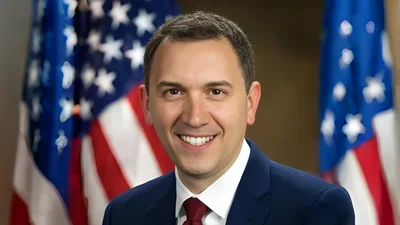Reflecting the U.S. Department of Transportation’s comprehensive approach to reducing serious injuries and deaths on our nation’s roads, officials from the Federal Highway Administration (FHWA), the National Highway Traffic Safety Administration (NHTSA) and the Federal Motor Carrier Safety Administration (FMCSA) today joined emergency responders representing transportation, public works, law enforcement, fire, emergency medical services, towing and recovery, and other rescue and emergency first responders to lead a Crash Responder Safety Week event at USDOT Headquarters.
The goal is to bring public attention to the men and women who risk their own safety to save lives at the scene of a crash. Crash Responder Safety Week runs from November 14-18 and is a national effort to both protect responders who are at the scene of highway crashes and remind the public of their responsibility to use caution when driving near roadside incidents involving emergency personnel.
“Whenever there’s a crash, our first responders act quickly to save the lives of those involved—and we must ensure their safety,” said U.S. Transportation Secretary Pete Buttigieg. “During this Crash Responder Safety Week, we must renew our efforts to protect all those involved in roadway crashes, including those who dedicate their lives to saving the lives of others.”
USDOT officials highlighted the Department’s comprehensive approach to safety through the National Roadway Safety Strategy (NRSS) and Safe System Approach – two key components that will help States, cities, and counties work toward USDOT’s ambitious goal of zero roadway fatalities, launched earlier this year to address the rise in deaths on our nation’s roads. Under the National Roadway Safety Strategy, post-crash care is one of five key tactics that will help crash victims receive medical care more quickly, and ultimately help more people survive roadway crashes, while creating a safe working environment for first responders and preventing secondary crashes through robust traffic incident management, or TIM, practices.
“Through the National Roadway Safety Strategy and our partnerships with state and local agencies, we are committed to supporting our nation’s emergency responders who save lives on a daily basis and inspire us with their courage and dedication,” said Acting Federal Highway Administrator Stephanie Pollack. “Emergency responders risk their lives to do their job – but they shouldn’t have to. That is why we are working to grow awareness of the risks that emergency responders face, so that we can make our roadways a safer place for all.”
“A key element of our National Roadway Safety Strategy is post-crash care. Reducing fatalities will take all of us working together in new ways, with new resources, and with new benchmarks,” said Ann Carlson, Acting Administrator of the National Highway Traffic Safety Administration. “Post-crash care is critical to saving lives, but we also need to protect first responders who put themselves in danger to provide aid at the scene of a crash. Every second counts in surviving a crash and Crash Responder Safety Week is an effort to protect emergency responders, who are risking their lives every day.”
“Crash Responder Safety Week shines a well-deserved spotlight on brave individuals who save countless lives with their decisive and courageous actions at roadway crash scenes,” said Robin Hutcheson, Administrator of FMCSA. “The Safe System Approach is based on knowing that, even in optimal safety environments, humans make mistakes. Our mission at FMCSA is to help ensure that nobody loses their life because of it. Crash responders keep people from dying in crashes and make it possible for us to envision reaching our goal of zero fatalities on America’s roadways.”
With safety as the top priority, FHWA has been working closely with stakeholders to advance the safety culture of incident response, encourage performance-driven safety practices, and advocate for the deployment of innovative safety countermeasures. FHWA launched Traffic Incident Management (TIM) training in 2012 designed by and for responders. The training helps teams of police, firefighters, highway workers, and emergency medical services and towing personnel ensure safe and effective coordination at a crash scene. In the TIM training, responders learn a common set of effective practices, including quick clearance techniques that improve communications and reduce the amount of time needed to remain on scene.
To date, more than 619,000 responders have been trained with the program, representing all 50 States, the District of Columbia and Puerto Rico. The training goes hand-in-hand with TIM tools, technologies, and policies to improve the safety of responders. The free training also allows responders to step back from the job of helping others to make sure they know the best practices to protect themselves.
FHWA’s TIM training supports the agency’s Safe Systems Approach – which means a road system that is designed and operated to protect every road user—motorists, cyclists, pedestrians, and traffic incident responders – along with the Department’s National Roadway Safety Strategy.
Working with our federal partners, NHTSA's Office of EMS advances a national vision for EMS through projects and research; fosters collaboration among federal agencies involved in EMS planning; measures the health of the nation's EMS systems; and delivers the data EMS leaders need to help advance their systems. NHTSA’s work spans 8 areas:
- Education: Supporting a nationwide systems approach to EMS education
- Workforce: Supporting efforts to strengthen workforce viability nationwide
- Research: Analyzing data and measuring performance to enable improvement in EMS systems
- EMS Data: Collecting & sharing standardized EMS data to support improvements in patient care and EMS systems
- Advancing EMS Systems: Supporting the importance of developing EMS as a coordinated system of care
- Preparedness: Fostering collaboration across the Federal Government to enhance readiness for catastrophic incidents
- Safety: Protecting the health & safety of EMS practitioners and their patients
- 911 System: Providing leadership and coordination to support and promote optimal 911 services
For more information on FHWA’s TIM training, please see here: Traffic Incident Management (TIM) - Office of Operations; the FHWA web-based TIM training is hosted at the National Highway Institute : Search for Courses.
For more information on the National Roadway Safety Strategy, please see https://www.transportation.gov/NRSS. The Department recently announced a new online dashboard that allows stakeholders and the general public to track the Department’s progress on commitments made as part of the NRSS.
Original source can be found here.




